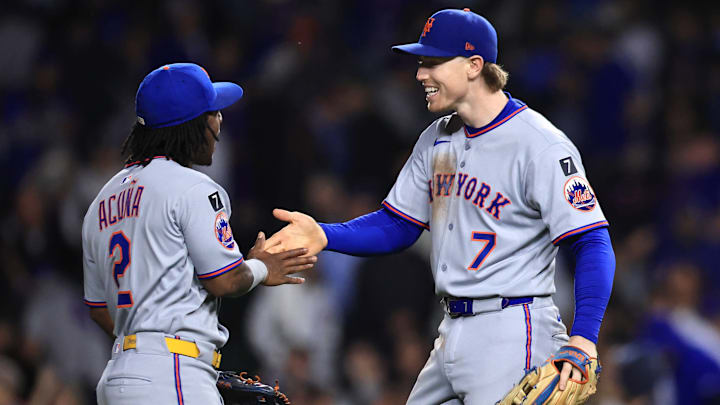The New York Mets didn’t just beat the Chicago Cubs last night; they offered a crash course in how quickly the fortunes of a ballgame swing on a few key choices. Some decisions injected energy into the lineup and gave the Mets the spark that shifted the balance of the night. Others showed the danger of waiting too long to act, with one call unraveling before anyone could stop the bleeding. It was a reminder that in baseball, boldness often sets the tone, but hesitation can leave even the best-laid plans in pieces.
Brett Baty starts at third base and delivers
With the Mets in a must-win game, Carlos Mendoza turned to Brett Baty at third base, a choice driven as much by defense as by circumstance. Mark Vientos has struggled in recent weeks, leaving the infield vulnerable, and against a tough lefty like Shota Imanaga, any defensive misstep could have resulted in runs and been costly for the team. Under normal conditions this season, Vientos might have started based on lefty-righty splits, but Mendoza opted for reliability.
After making a smooth play in the field, Brett Baty doubles the @Mets lead with a 3-run blast! pic.twitter.com/jnMm0knUeT
— MLB (@MLB) September 26, 2025
Baty didn’t just provide security; he swung the game in the Mets’ favor. He went 2-for-4 with a homer, three RBIs, and two runs scored. That homer came off Imanaga, who has held lefties to a .194 average and a .572 OPS this season, making Baty’s power even more striking. In a contest where every run counted, his bat and glove together justified Mendoza’s decision and gave New York the momentum it needed. Don't be surprised to see him stationed there for the remaining three games.
Tyrone Taylor returns to centerfield and makes an impact
After joining the Mets on Wednesday following a stint on the IL, Tyrone Taylor was called on to stabilize centerfield. Defense had been a revolving door, with Cedric Mullins and Jose Siri struggling, and even Brandon Nimmo temporarily shifted from left to plug gaps. Mendoza needed a reliable glove, and Taylor’s return offered exactly that: a chance to stop runs before they started and give New York a firmer grip on the game.
A 2-run double for Tyrone Taylor and it's 8-2 Mets! pic.twitter.com/lULevmITZH
— SNY (@SNYtv) September 26, 2025
Taylor didn’t just settle in; he made a statement. He went 2-for-4 with a clutch two-run double in the sixth inning, a moment that came right after the Cubs cut the lead to 6-2. His presence in centerfield gave the Mets both defensive security and an offensive spark, proving that Mendoza’s decision to start him was a calculated move that paid off immediately.
Nolan McLean stayed in the game too long
Nolan McLean had been untouchable through the first five innings, striking out 11 and allowing only two solo homers. The Mets carried a solid lead, and everything suggested a clean path through the sixth. But the story isn’t about McLean’s performance—it’s about the call that followed. Mendoza let his starter stay in past the point where signs of fatigue were clear, a choice that would soon shift the game’s momentum.
By the sixth inning, McLean’s pitch count had climbed into the 90s, and trouble was brewing. After a walk and a double, he faced a hitter who had already tagged him for a home run earlier. Mendoza left him on the mound, and the decision backfired, allowing the Cubs to cut into the lead. With the Mets unable to afford a slip in any of the next three games, managerial decisions like this can’t backfire.
